Here’s everything you need to know about Winchester Short Magnum family of cartridges (the 270 WSM, 7mm WSM, 300 WSM, and 325 WSM) and how they compare to popular standard length cartridges.
I think we can agree that most hunters and shooters in North America are probably familiar with the venerable .270 Winchester, 7mm Remington Magnum, .300 Winchester Magnum cartridges. All are very solid performers that are extremely popular with big game hunters pursuing game like deer, elk, black bear, and moose. Not surprisingly, many sportsmen and women were a little skeptical about the line of Winchester Short Magnum cartridges introduced in the early 2000s that claimed to offer even better performance than these legendary centerfire rifle hunting cartridges.
Specifically, the new 270 WSM, 7mm WSM, 300 WSM, and 325 WSM cartridges were all designed to use a very compact case that would fit in a short action rifle. Winchester claimed these new cartridges could meet or even exceed the ballistic performance of comparable standard length cartridges like the .270 Winchester, the 7mm Remington Magnum, and .300 Winchester Magnum. Additionally, the company also advertised that the shorter case used by the WSM cartridges resulted in superior accuracy and less recoil.
Is this really the case? Do the WSM cartridges offer tangible benefits to hunters and shooters? Or was the Winchester Short Magnum line of cartridges just a scheme by Winchester to sell new rifles that’s cleverly disguised by a bunch of marketing hype?
In this article, I’m going to do a detailed analysis of the 270, 7mm, 300, and 325 Winchester Short Magnum cartridges and compare them to the .270 Winchester, the 7mm Remington Magnum, the .300 Winchester Magnum, and the .338 Winchester Magnum in an effort to answer the above questions and parse out the their true strengths and weaknesses so you can make an informed decision regarding which one will work best for you.
Before we get started, I have an administrative note:
Some of the links below are affiliate links. This means I will earn a small commission (at no extra cost to you) if you make a purchase. This helps support the blog and allows me to continue to create free content that’s useful to hunters like yourself. Thanks for your support.
Winchester Short Magnum History
First, let’s talk about the history of the Winchester Short Magnum (WSM) line of cartridges and what the company was trying to achieve.
Benchrest shooters discovered many years ago they could obtain a small, but definite advantage in accuracy by using short, stubby cartridges.
Many of the most popular centerfire rifle cartridges in the United States, like the .270 Winchester and .30-06 Springfield (both of which have an overall length 3.34″), require the use of what is commonly referred to as a “standard action” or “long-action” rifle. However, other cartridges, like the 6.5 Creedmoor and .308 Winchester (which have overall lengths of 2.825″ and 2.81″ respectively), are about a half inch shorter and will therefore fit into what’s commonly known as a “short-action” rifle.
Note: these are not the only broad categories of rifle actions. For example, so called “magnum actions” are even longer than standard actions. However, standard/long actions and short actions are two of the most common and are most relevant to the development of the Winchester Short Magnum line of cartridges.
The exact size of the rifle action (which includes the locking bolt, firing pin, etc.) varies from company to company, but the basic trend is the same regardless of the exact rifle we’re talking about.
Makes sense right?
After all, a longer cartridge simply requires more space to feed and eject than a shorter cartridge.
This means that it’s possible to build a short action rifle that’s a tiny bit shorter and lighter than an otherwise identical rifle with a standard length action. So, not only is it possible to shave some length and weight off a rifle while retaining the same length barrel, but shorter actions also give the shooter an advantage from a shorter bolt throw (and a correspondingly faster cycling time) as well as a tiny advantage in accuracy due to their stiffer action.
With this in mind, designers at Winchester Repeating Arms elected to build a line of cartridges that could fit in a short length action with the goal of achieving similar performance to popular standard length cartridges. Basically, their stated goal was to give shooters and hunters all the benefits of a short action cartridge (like the .308 Winchester pictured below) with essentially the same external ballistics as comparable standard length cartridges (like the .270 Winchester cartridge in the photo below).
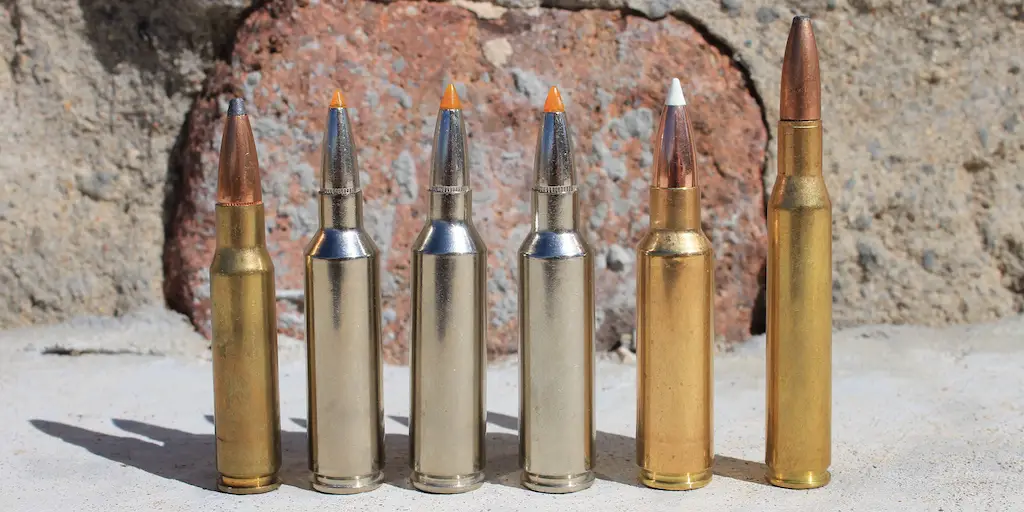
So, how’d they do it?
The modern “magnum era” began in earnest with the introduction of the 7mm Remington Magnum and .300 Winchester Magnum cartridges during the 1960s. Both cartridges use cases derived from the long, belted .375 H&H Magnum. However, the Winchester Short Magnum cartridges all use a much fatter case without a belt that more closely resembles the case used by the old .404 Jeffery as well as the later Winchester Super Short Magnum (WSSM) line of cartridges.
The WSM cases all have a .535″ rebated rim that’s compatible with a standard magnum size bolt face. However, their .555″ case diameter is larger than those used by the 7mm Rem Mag and .300 Win Mag (.513″) as well as the .270 Winchester (.470″). Additionally, the Winchester Short Magnum Cartridges all have a case with very minimal taper and a 35 degree shoulder.
Taken together, these factors all maximize the case capacity of the WSM cartridges, even though their overall length of 2.86″ is still short enough to fit in a short-action rifle.
Proponents of the WSM cartridges also argue that this results in a shorter and wider powder column that’s more quickly ignited by the primer and burns more evenly than a comparable amount of powder in a longer and more narrow column. In theory, this results in improved accuracy for the shorter case.
Now, the Winchester Short Magnum cartridges were not the first commercially produced short magnums. Indeed, the 6.5 Remington Magnum, the .350 Remington Magnum, and the line of proprietary Lazzeroni cartridges all came on the scene before the WSM line, but none really caught fire for various reasons.
However, Winchester made a big splash with the .300 Winchester Short Magnum in 2001 and followed up with the .270 Winchester Short Magnum and 7mm Winchester Short Magnum cartridges in 2002. They rounded out the lineup with the 325 Winchester Short Magnum in 2005.
The first three cartridges were all designed and marketed specifically as short action alternatives to extremely popular and effective standard length cartridges: the .270 Winchester for the .270 Winchester Short Magnum, the 7mm Remington Magnum for the 7mm Winchester Short Magnum, and the .300 Winchester Magnum for the 300 Winchester Short Magnum.
However, the 325 Winchester Short Magnum doesn’t have a closely related standard length cousin that’s widely used in North America. The 325 WSM has similar ballistics to the magnum action, medium bore 8mm Remington Magnum and 8×68 S cartridges. However, though the 8×68 S is relatively popular in Europe, 8mm cartridges simply aren’t very popular in North America and neither cartridge is widely used on this side of the Atlantic. For that reason, the .338 Winchester Magnum is probably the closest comparison to the .325 WSM that’s in common use in North America.
Now that we’ve covered the basic history and design of the Winchester Short Magnum cartridges, let’s see how they compare to the .270 Winchester, 7mm Remington Magnum, 300 Winchester Magnum, and .338 Winchester Magnum. Scroll down or click the appropriate link below to jump to the specific comparison you want to learn more about.
270 WSM vs 270 Winchester
7mm WSM vs 7mm Rem Mag
300 WSM vs 300 Win Mag
325 WSM vs 338 Win Mag
Note: No company currently manufactures rifles chambered in 7mm WSM. However, Winchester did produce several versions of their Model 70 chambered in the cartridge for many years. In order to make as close to an “apples to apples” comparison of the cartridges as possible, I referenced Winchester’s 2009 catalog and used the provided specifications listed there for the Model 70 Featherweight chambered in .270 Win, 270 WSM, 7mm Rem Mag, 7mm WSM, 300 Win Mag, 300 WSM, 325 WSM, and 338 Win Mag.
270 WSM vs 270 Winchester
The differences in external dimensions between the .270 Winchester and 270 WSM obvious in the photo below.
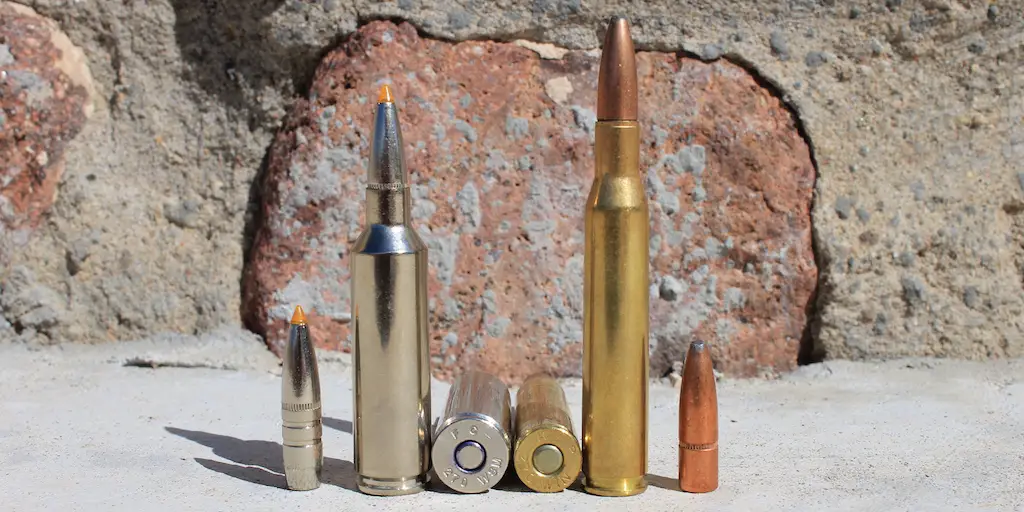
First, the .270 Winchester is significantly longer. This makes sense since the 270 WSM is specifically designed to fit in a short action rifle instead of a standard length action like the .270 Winchester. However, the 270 WSM has a very fat case with minimal taper and a much steeper shoulder angle (35 degrees vs 17.5 degrees).
For those reasons, the 270 WSM is unique among the Winchester Short Magnum cartridges for actually having significantly more case capacity (around 10-20% more, depending on the case manufacturer) than its standard length cousin.
Additionally, while neither cartridge has a belt, the .270 Winchester uses a traditional rimless design while the 270 WSM has a rebated rim.
However, the two cartridges have some similarities as well.

First, both have the same maximum SAAMI pressure of 65,000psi. Second, both cartridges use the same .277″ diameter bullets. Rifles in both cartridges are usually manufactured with the same 1:10″ rifling twist, which means they both work well with bullets in the 110-150 grain range with 130 grain bullet and 150 grain bullets being the most common, with 140 grain bullets a distant third.
When you consider the fact that the 270 WSM has significantly more case capacity than the older .270 Winchester and that both cartridges have the same maximum SAAMI pressure, it shouldn’t be surprising that the 270 WSM is actually capable of shooting the same weight bullet at a higher velocity than the .270 Winchester.
This is illustrated in the table below comparing Federal Premium factory ammunition loaded with 130gr Trophy Bonded Tip (.44 BC) and 150gr Nosler Partition (.466 BC) bullets in .270 Winchester and 270 WSM.
All four loads used a 200 yard zero.
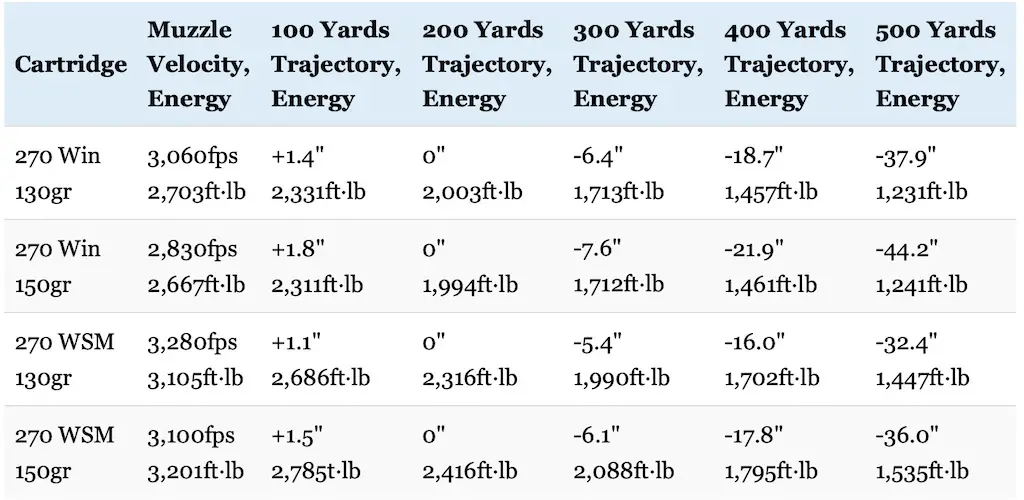
As you can see, since the loads for each cartridge used the exact same bullet, and since the 270 WSM has an advantage (about 200-300 fps) in velocity, it has a flatter trajectory than the .270 Winchester that’s nearly on par with the .270 Weatherby (270 Wby).
The .270 Win has a relatively flat trajectory itself, but the 270 WSM has a definite advantage in this area.
The chart below compares how much a 10 mile per hour crosswind impacts those same four loads out to 500 yards.
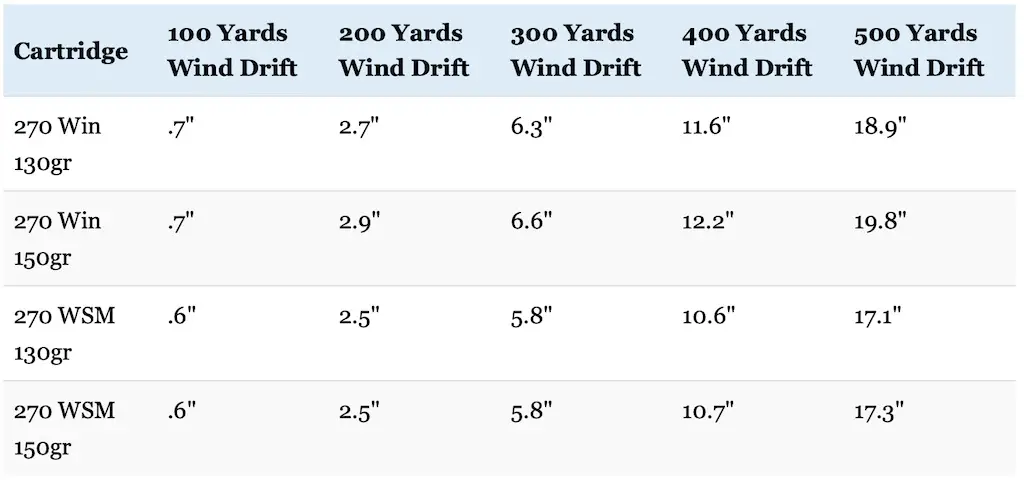
Once again, the 270 WSM has an advantage over the .270 Winchester in this area. However, it’s a small edge due entirely to the slightly faster muzzle velocity of the Winchester Short Magnum cartridge.
Now let’s talk about recoil.
The table below compares the recoil produced by two Nosler hand loads (available here and here) with ballistics roughly comparable to the 130gr loads above for those cartridges when fired from a Winchester Model 70 Featherweight rifle. This specific model weighs 7.25 pounds when chambered in 270 WSM and 7 pounds when chambered in .270 Winchester.
Felt recoil will vary from shooter to shooter and rifle to rifle, but free recoil energy is still a useful way to compare cartridges.
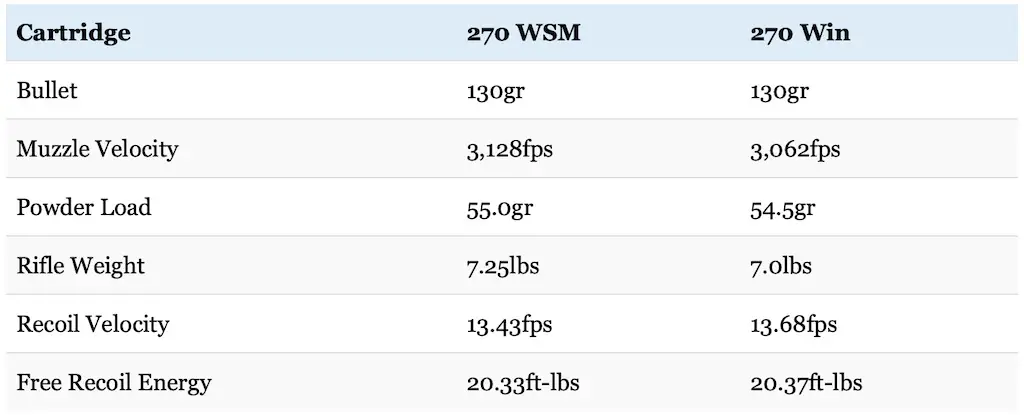
As you can see, the two cartridges have almost identical amounts of recoil with the 270 WSM in this particular example actually having a tiny bit less free recoil energy than the .270 Winchester. However, the 270 WSM uses a heavier rifle and the .270 Winchester gets a slight edge when both are used in the same weight rifle.
These two cartridges present an interesting case though.
Since the 270 WSM uses a significantly shorter cartridge, you’d probably expect rifles in that cartridge to be shorter and lighter than rifles chambered in .270 Winchester. Normally you’d be right and the rifle for the standard length cartridge would be either a little longer and heavier or virtually the same size and weight.
That’s not the case here though.
While rifles chambered in both cartridges are manufactured with both 22″ and 24″ barrels, the shorter 22″ barrel length is more common with the .270 Winchester and the longer 24″ barrel is more common with the 270 WSM. For this reason, this particular Model 70 in 270 WSM is actually longer (44″ vs 42.5″) and heavier (7.25 pounds vs 7 pounds) than the Model 70 in .270 Winchester.
This is not a hard and fast rule, but it is a common occurrence with these two particular cartridges.
It’s not a gigantic difference, but this often means that the 270 WSM has a definite advantage in terms of external ballistics and sometimes slightly less recoil, but that the .270 Winchester is more often available in shorter, lighter, and easier to handle rifles.
However, regardless of the firearm in question, rifles chambered in .270 Winchester can usually hold an extra round or two in the magazine since that cartridge has a slimmer case. For example, 4-5 round magazines are pretty common with the .270 Win, but 3 round magazines are about all you’ll find with the 270 WSM.
In that same vein, those fat, stubby 270 WSM cartridges with their very steep shoulder angle can sometimes present feeding problems. This is not always the case and some 270 WSM rifles feed exceptionally reliably of course, but it’s likely more of an issue with that cartridge that’s not often encountered with the 270 and its longer, slimmer, and more tapered case.
What about accuracy of the 270 Winchester vs 270 WSM? After all, fans of the Winchester Short Magnum cartridges like to point out the benefits of the shorter and fatter powder column.
The 270 Winchester Short Magnum very likely does gain some accuracy benefit from its shorter powder column. However, there are many, many other factors that influence accuracy more than that one trait.
Is the 270 WSM capable of excellent accuracy? Absolutely.
Is it significantly more accurate than the .270 Winchester? Probably not.
Does the difference between the two cartridges in terms of accuracy make a difference for most hunters under typical conditions? Again, probably not.
The answers to the above questions really depend on the rifle, ammunition, and shooter in question though. However, both cartridges are capable of excellent accuracy in the right hands and will get the job done under most circumstances if the shooter is up to the task.
What about rifles and ammunition?
The .270 Winchester is one of the most popular centerfire rifle cartridges in North America and is very likely among the Top 10 (maybe Top 5) best selling rifle cartridges in the United States each year. The 270 WSM is relatively popular itself (probably the second most popular Winchester Short Magnum cartridge behind the 300 WSM), but it can’t hold a candle to the .270 Winchester in terms of overall availability.
The 270 WSM is by no means rare though and most sporting goods stores carry ammunition for both cartridges. That being said, it’s probably a little bit more expensive and, while there’s a good variety of ammo for the cartridge, the .270 Winchester usually has a bigger selection regardless of where you go.
Both cartridges are also well suited for hand loaders and reloading components for the .270 Winchester and 270 WSM are widely available. The .270 Winchester and 270 WSM (along with the .270 Weatherby and the 6.8 SPC) use the same .277″ diameter bullets. Due to the long running popularity of the .270 Winchester, there’s a plethora of quality bullets to choose from for both cartridges.
The same goes for guns: rifles chambered in .270 Winchester are among the most commonly produced centerfire rifles in the United States. Once again, there’s a good selection for both, but rifles chambered in 270 WSM aren’t quite as common and are usually more expensive.
So where do we stand with both cartridges?
The 270 WSM does indeed have a flatter trajectory and more resistance to wind drift than the .270 Winchester. It also carries more energy out to longer range and is capable of excellent accuracy.
On the other hand, while the 270 WSM cartridge has an advantage over the 270 Winchester, I wouldn’t say it’s a gigantic difference either.
That extra velocity makes a difference in terms of wind drift and overall trajectory to be sure, but that slightly flatter trajectory is less important in this day and age of laser rangefinders, particularly if you have a scope equipped with a bullet drop compensating dial.
Basically, the .270 Winchester and .270 Winchester Short Magnum are best suited for the same hunting situations. Both will work exceptionally well on deer sized game out to several hundred yards. Both are wonderful for situations like hunting mule deer in Arizona or pronghorn in Wyoming. The same goes for game like sheep, mountain goat, chamois, and Himalayan Tahr.
You can even use them both on larger game like kudu, eland, red stag, elk, and moose with great results.
At reasonable shooting ranges, both cartridges will really do a number on many species of game. Though I doubt that a well placed shot on an animal with an extra 200 feet per second of velocity or 250 foot pounds of energy will make a big difference, it won’t necessarily hurt either and I can see why someone would want that extra power, especially when hunting game like elk and moose.
However, don’t underestimate the importance of the greater variety, wider availability, and lower overall cost of .270 Winchester rifles and ammunition. The generally better feeding and overall reliability of most .270 Win rifles is a big plus as well. Finally, it’s also nice to have that extra round or two of ammunition in your magazine available if you end up needing it one day.
The verdict?
They’re both great cartridges, but I’d probably lean towards the .270 Winchester. There’s not a darn thing wrong with the 270 WSM either though and there’s really no reason to make a switch either if you already have a good hunting rifle chambered in either cartridge that you like.
7mm WSM vs 7mm Rem Mag
As you can see in the photo below, there are some pretty big differences in external dimensions between the 7mm WSM and the 7mm Rem Mag.
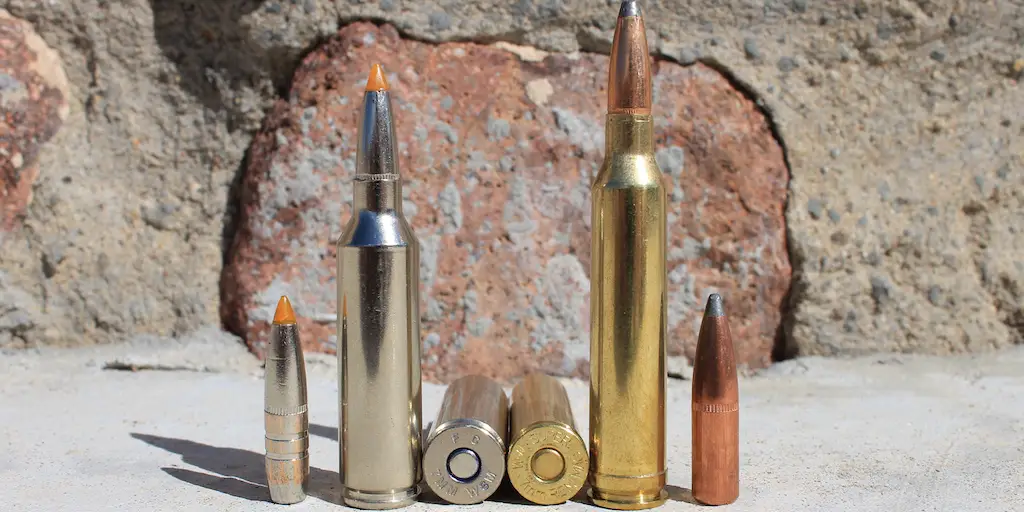
First, the 7mm Remington Magnum cartridge is significantly longer. This makes sense since the 7mm WSM is specifically designed to fit in a short action rifle instead of a standard length action like the 7mm Rem Mag. However, even though the 7mm Mag is derived from the .375 H&H Magnum and itself uses a fatter case than cartridges like the .270 Winchester and .30-06 Springfield, the 7mm WSM still has a significantly fatter case with less taper and a steeper shoulder angle (35 degrees vs 25 degrees).
Even though the 7mm WSM uses a larger diameter case, the 7mm Rem Mag uses a relatively large diameter case itself and is significantly longer. For those reasons, the two cartridges have very similar case capacity, but the 7mm Rem Mag can hold a tiny bit more powder than the 7mm WSM.
Additionally, the 7mm Remington Magnum is a traditional belted magnum while the 7mm WSM has a rebated rim and no belt.
The 7mm WSM also has a higher maximum SAAMI pressure than the 7mm Remington Magnum (65,000psi vs 61,000psi).
Finally, while the two cartridges use the same 7mm bullets (.284″ diameter) and there is a big overlap in typical bullet weights for each cartridge, the 7mm WSM normally uses lighter bullets than the 7mm Remington Magnum.
For instance, the vast majority of 7mm Rem Mag factory loads shoot bullets in the 139-175 grain range. Of these, 140 grain, 150 grain, 160 grain, and 175 grain loads are by far the most common.
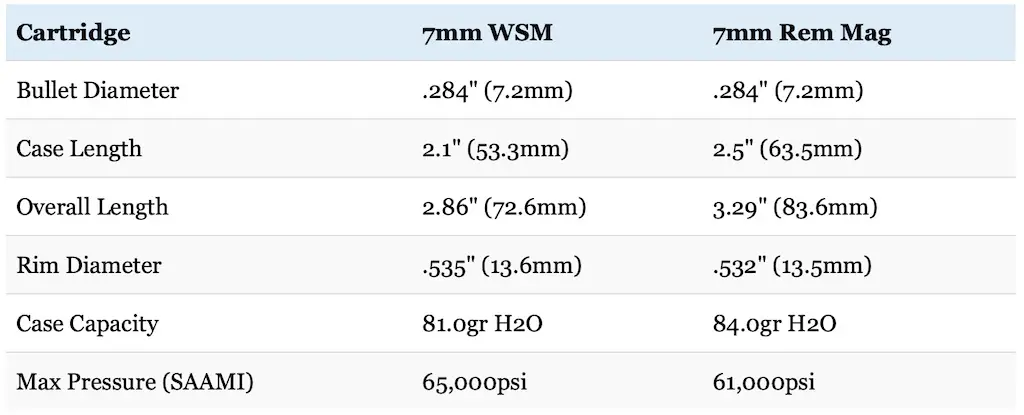
On the other hand, the majority of 7mm WSM factory loads use bullets in the 140-162 grain range and 140, 150, and 162gr bullets are pretty common. Factory loads for the 7mm WSM and 7mm Rem Mag often use the exact same bullets fired at virtually the same muzzle velocity. As you can probably guess, there is very little difference in the trajectories in the two cartridges.
This is illustrated in the table below comparing Federal Premium and Hornady factory ammunition loaded with 140gr Trophy Bonded Tip (.430 BC) and 162gr ELD-X (.631 BC) bullets in 7mm WSM and 7mm Rem Mag.
With these loads, the bullet from the 7mm WSM is going 50-60 feet per second faster than the bullet from the 7mm Rem Mag. This is an incredibly small practical difference.
Indeed, it’s even possible to see that much shot to shot variation within the same box of ammo for a particular cartridge. So, while the 7mm WSM is faster on paper, the two cartridges have essentially the same velocity for all intents and purposes.
All four loads used a 200 yard zero.
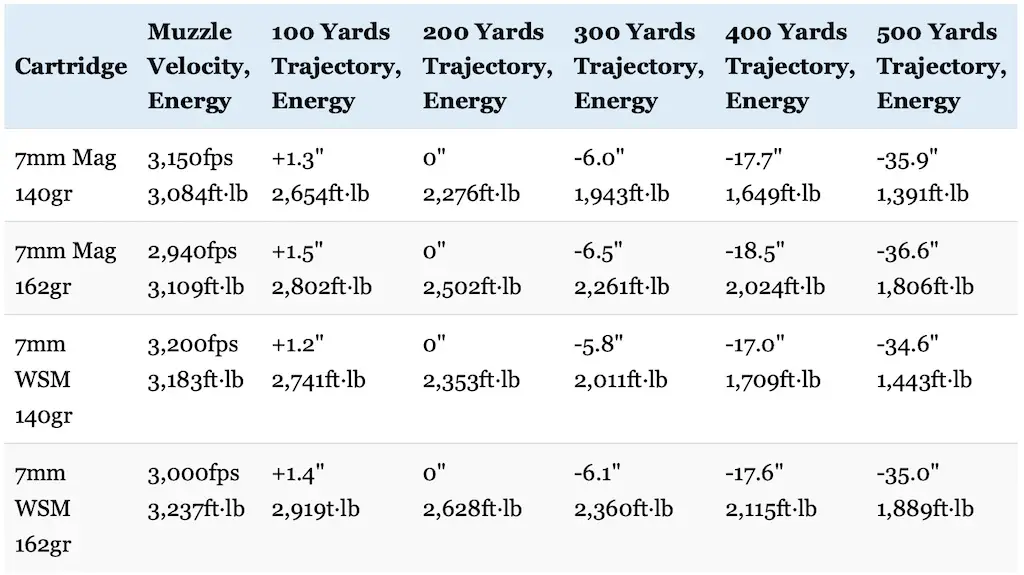
As you can see, since the loads for each cartridge used the exact same bullet and since there is an extremely small difference in velocity between the two cartridges, they each have virtually the same bullet trajectory.
The chart below compares how much a 10 mile per hour crosswind impacts those same four loads out to 500 yards.
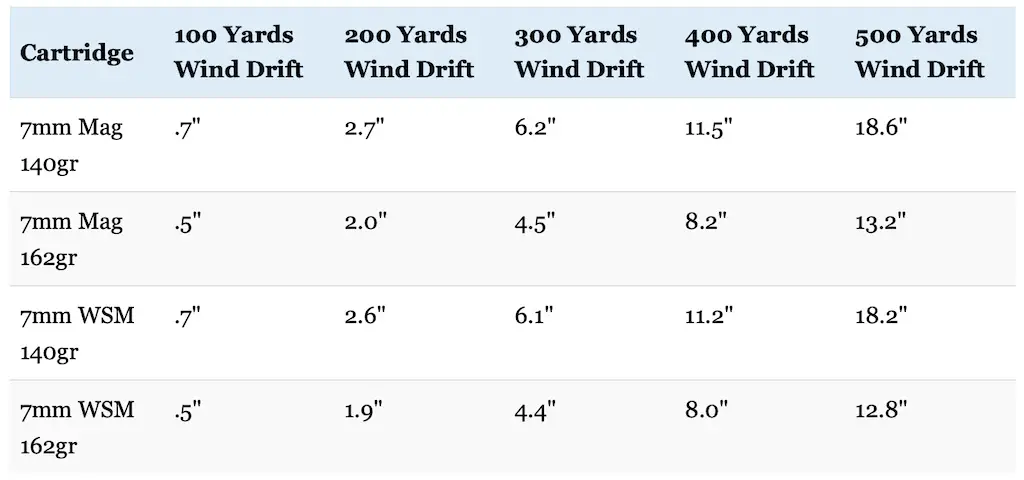
Once again, the 7mm WSM has a little bit less wind drift, but it’s an extremely small difference between them that’s due entirely to the slightly faster muzzle velocity of the Winchester Short Magnum cartridge.
Now let’s talk about recoil.
The table below compares the recoil produced by two Nosler hand loads (available here and here) with ballistics roughly comparable to the 140gr loads above for those cartridges when fired from a Winchester Model 70 Featherweight rifle. This specific model weighs 7.25 pounds when chambered in both 7mm WSM and 7mm Rem Mag.
Felt recoil will vary from shooter to shooter and rifle to rifle, but free recoil energy is still a useful way to compare cartridges.
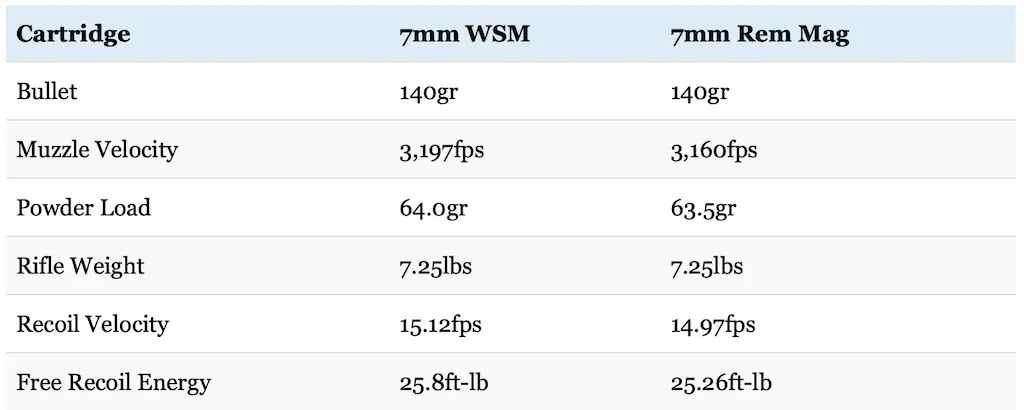
As you can see, the two cartridges have almost identical amounts of recoil with the 7mm Rem Mag in this particular example actually having a tiny bit less free recoil energy than the 7mm WSM. Once again, there is essentially no difference between the recoil of the two cartridges though.
Though Winchester advertises a 24″ long barrel and a 7.25 pound overall weight for each cartridge in this particular Model 70, the rifle chambered in 7mm WSM is 1/2″ shorter overall. So, while the rifle chambered in 7mm WSM is not really any lighter, it’s a tiny bit shorter and handier.
Both rifles in this case also have a 3 round magazine as well, so there’s no advantage there with either cartridge. This is not a hard and fast rule though and it’s sometimes possible to find rifles chambered in 7mm Remington Magnum that can accommodate another round or two compared to those chambered in 7mm WSM.
Just like with the 270 WSM, this is due to the very large diameter of the 7mm WSM cases that simply take up more space in a rifle magazine than the thinner 7mm Rem Mag case. In that same vein, those fat, stubby 7mm WSM cartridges with their very steep shoulder angle can sometimes present feeding problems. Of course, this is not always the case and some rifles chambered in 7mm WSM rifles feed quite reliably, but it’s more of an issue with that cartridge that’s not as often encountered with the 7mm Rem Mag and its longer, slimmer, and more tapered case.
What about accuracy of the 7mm WSM vs 7mm Rem Mag? After all, fans of the Winchester Short Magnum cartridges like to point out the benefits of the shorter and fatter powder column. The 7mm Winchester Short Magnum very likely does gain some accuracy benefit from its shorter and fatter powder column.
However, while that factor may well contribute to better accuracy, there are many other factors that influence accuracy to a much larger degree.
Is the 7mm WSM capable of excellent accuracy? Absolutely.
Is it significantly more accurate than the 7mm Remington Magnum? Maybe, but probably not.
Does the difference between the two cartridges in terms of accuracy make a difference for most hunters under typical conditions? Again, probably not.
The answers to the above questions really depend on the rifle, ammunition, and shooter in question though. However, both the 7mm Remington Magnum and 7mm Winchester Short Magnum cartridges are capable of excellent accuracy in the right hands and will get the job done under most circumstances if the shooter is up to the task.
What about rifles and ammunition?
The 7mm Remington Magnum is one of the most popular centerfire rifle cartridges in North America and is likely among the Top 10 best selling rifle cartridges in the United States. Virtually every major brand of ammo is available in 7mm Rem Mag.
While I would not describe the 7mm WSM as a rare or hard to find cartridge, it’s not especially popular or widely available. There is a decent selection of factory ammo available in the cartridge from companies like Federal, Hornady, and Winchester.
Both cartridges are also well suited for hand loaders and reloading components for the 7mm Remington Magnum and 7mm Winchester Short Magnum are widely available. The two cartridges (along with others like the 7mm Mauser, 7mm-08, 7mm Weatherby, 280 Remington, 280 Ackley Improved, and 7mm Remington Ultra Magnum) use the same .284″ bullets. Due to the long running popularity of 7mm cartridges like those just mentioned, there’s a great selection of quality bullets to choose from for both cartridges.
The same goes for guns: rifles chambered in 7mm Remington Magnum are extremely popular and very commonly in the United States. This is not the case for the 7mm WSM though. While rifles like the Winchester Model 70 were produced in that chambering for several years, I’m not aware of any rifles currently manufactured in 7mm WSM.
This is obviously not great news for fans of the 7mm Winchester Short Magnum and does not bode well for the future of the cartridge.
So where do we stand with both cartridges?
The 7mm WSM does indeed have a flatter trajectory and a tiny bit more resistance to wind drift than the 7mm Rem Mag. It also carries a tad more energy out to longer range and is capable of excellent accuracy.
On the other hand, the Winchester Short Magnum cartridge does not have a gigantic advantage in either category either and there’s actually a smaller difference in the ballistics of the 7mm WSM vs 7mm Rem Mag than there is with the 270 WSM vs 270 Winchester.
The 7mm WSM and 7mm Remington Magnum are best suited for the exact same hunting situations. Both will work exceptionally well on game ranging from whitetail, mule, and fallow deer all the way up to elk and moose out to several hundred yards. The same goes for game like mountain goat, bighorn sheep, Himalayan Tahr, and chamois.
For all intents and purposes, there is no difference between them ballistically and both cartridges will really do a number on most species of big game. However, the 7mm Remington Magnum has a gigantic advantage in terms of availability and variety of rifles and ammunition. The generally better feeding and overall reliability of most 7mm Remington Magnum rifles is a big plus as well.
The verdict?
They’re both solid performing cartridges, but I’d personally choose the 7mm Remington Magnum over the 7mm Winchester Short Magnum. If you already have a rifle in the cartridge and don’t mind the smaller selection of factory ammo (or if you’re into handloading), the 7mm WSM will also serve you very well as a hunting cartridge.
Unfortunately, the future isn’t looking very bright for that cartridge right now. Prospects for new rifles chambered in 7mm Winchester Short Magnum are already pretty dim and it’s possible that things will also be heading that way soon with factory ammo.
300 WSM vs 300 Win Mag
The photo below does a great job of showing the differences in external dimensions between the 300 Winchester Magnum and the 300 Winchester Short Magnum.
First, the .300 Win Mag is a lot longer. This shouldn’t be surprising though because the 300 WSM is specifically designed to fit in a short action rifle instead of a standard length action like the larger .300 Winchester Magnum.
However, though the .300 Win Mag (like the 7mm Rem Mag) is derived from the .375 H&H Magnum and uses a fatter case than cartridges like the .270 and .30-06, the 300 WSM still has a much fatter case with less taper and a steeper shoulder angle (35 degrees vs 25 degrees).
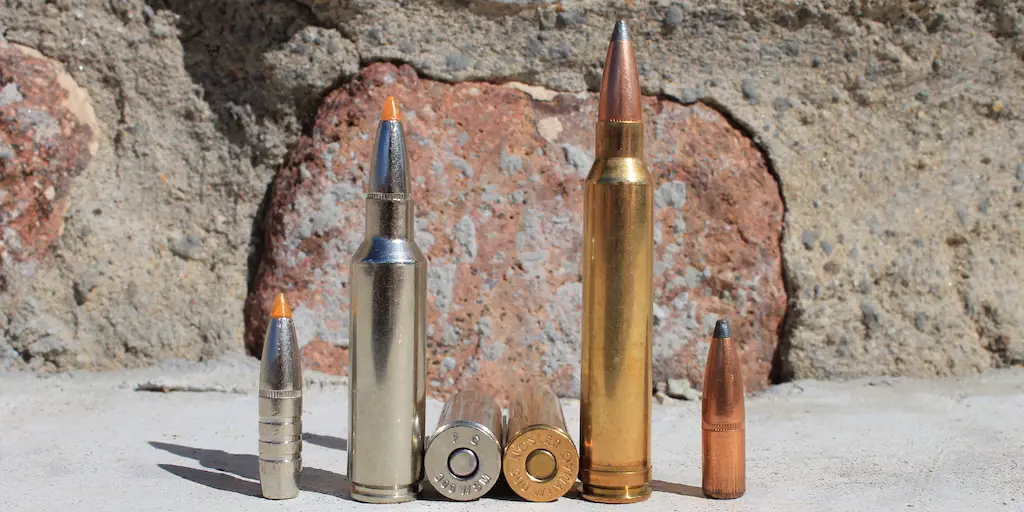
Additionally, the .300 Winchester Magnum is a traditional belted magnum while the 300 WSM has a rebated rim and no belt.
Just like with the 7mm WSM vs 7mm Rem Mag, even though the 300 WSM uses a case with a larger diameter, the .300 Win Mag also uses a relatively large diameter case itself and is significantly longer. Additionally, the .300 Win Mag has a shoulder moved further forward than the 7mm Rem Mag. For those reasons, the .300 Win Mag actually has significantly more case capacity (around 10-15% more, depending on the manufacturer) than the 300 WSM.
On the other hand, the 300 WSM has a slightly higher maximum SAAMI pressure than the .300 Winchester Magnum (65,000psi vs 64,000psi).
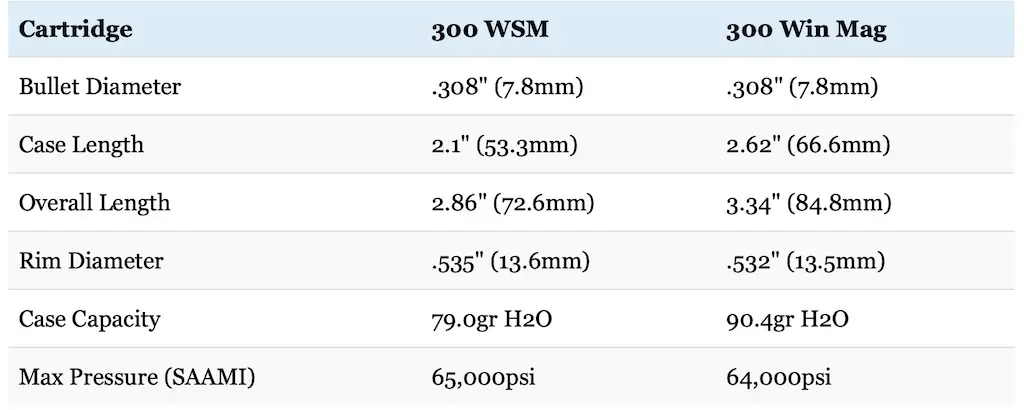
Finally, the two cartridges use the same .308″ diameter bullets and there is a big overlap in typical bullet weights for each cartridge.
Both cartridges normally use bullets in 150-230 grain range. 150 grain, 165 grain, 180 grain, 190 grain, 200 grain, and 220 grain bullets are the most popular.Similar to the case with the 7mm WSM vs 7mm Rem Mag, the 300 WSM and .300 Win Mag factory loads often fire the exact same bullet at virtually identical velocities. In fact, the difference in published velocity is often smaller for the 300 WSM vs 300 Win Mag than the 7mm WSM and 7mm Rem Mag.
This is illustrated in the table below comparing Federal Premium and Hornady factory ammunition loaded with 180gr Trophy Bonded Tip (.500 BC) and 200gr Hornady ELD-X (.597 BC) bullets in .300 Winchester Magnum and 300 Winchester Short Magnum.
As you can see, the two Federal Premium loads used the exact same 180 grain bullets fired at the same velocity. The two Hornady loads fired the same bullet with a scant 30 fps of difference between them, with the .300 Win Mag having a tiny velocity edge.
This is an incredibly small practical difference. In fact, depending on the exact brand of factory ammo we’re talking about (like Barnes VOR-TX), the 300 WSM may have a faster published velocity. For all intents and purposes, we can say that the two cartridges have the same ballistics.
All four loads used a 200 yard zero.
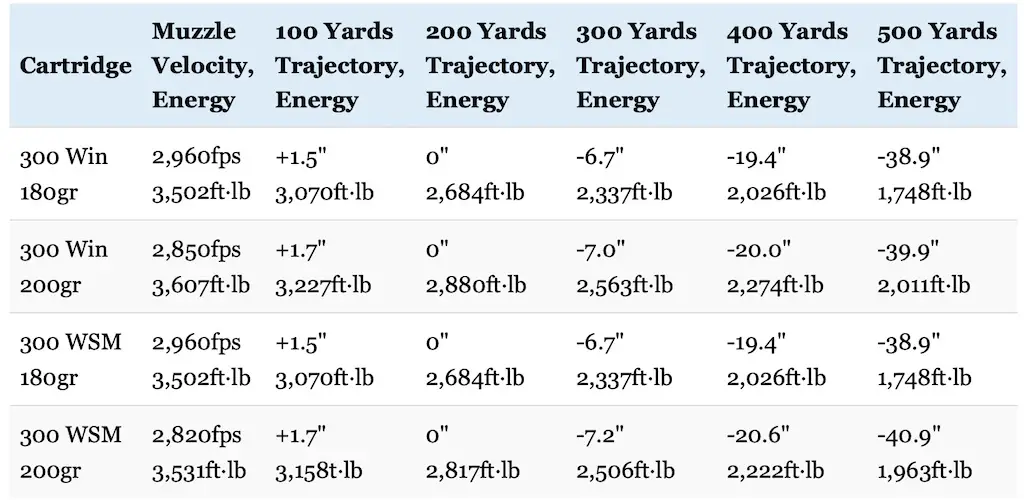
Just like you’d expect, there is virtually no difference between the trajectory of each cartridge. The Hornady .300 Win Mag shoots a little bit flatter due to its faster muzzle velocity, but the difference between them is so small that it’s probably not even worth considering.
The chart below compares how much a 10 mile per hour crosswind impacts those same four loads out to 500 yards.
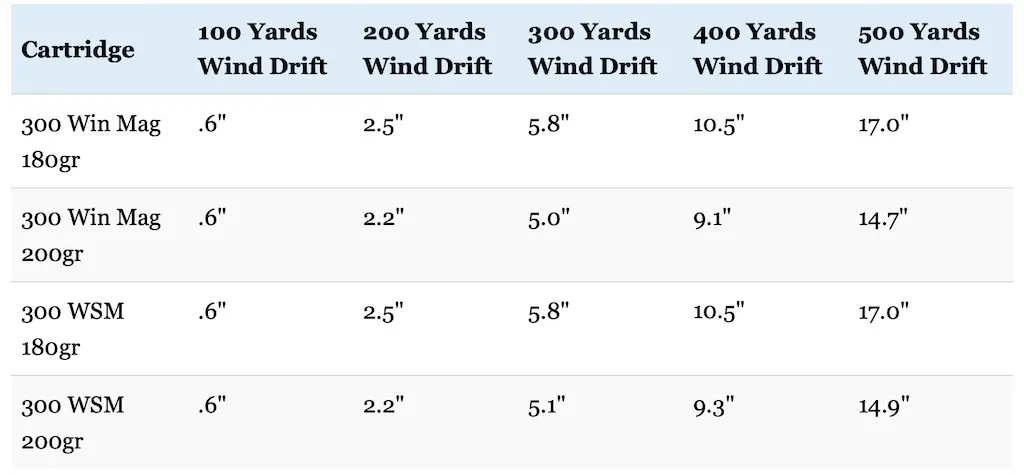
Once again, the .300 Win Mag Hornady load has the edge over the 300 WSM in this area. But just like with trajectory though, they are close enough that you can say they have essentially the same amount of wind drift.
Now let’s talk about recoil.
The table below compares the recoil produced by two Nosler hand loads (available here and here) firing 200gr Nosler AccuBonds at virtually the same velocity: 2,885fps for the 300 WSM and 2,910 for the .300 Win Mag. Both loads are compared when fired from a Winchester Model 70 Featherweight rifle. This specific model weighs 7.25 pounds when chambered in both 300 WSM and .300 Winchester Magnum.
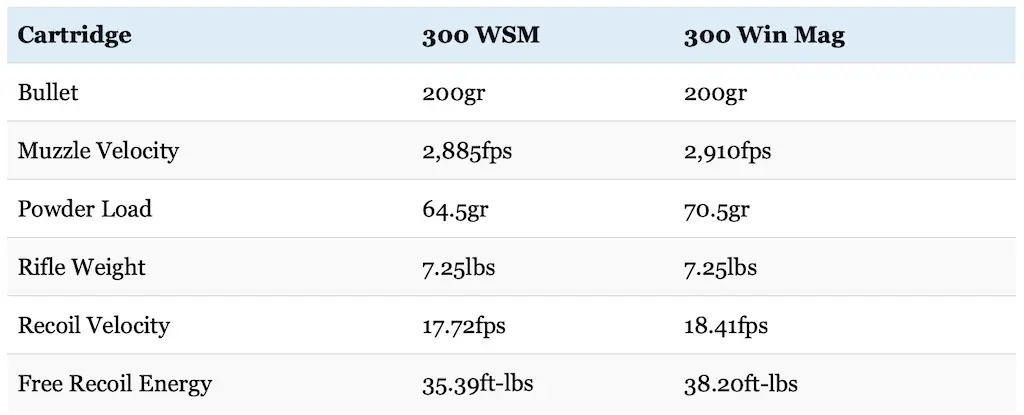
Felt recoil will vary from shooter to shooter and rifle to rifle, but free recoil energy is still a useful way to compare cartridges.
This is the first instance where we’ve seen the Winchester Short Magnum serve up similar performance with an appreciable reduction in recoil. The particular 300 WSM load above shoots the same weight bullet at very nearly the same muzzle velocity (over 99% as fast), but uses about 8.5% less powder. Those factors result in this particular 300 WSM load having about 7% less free recoil than the .300 Win Mag.
How big of a difference does that make?
That’s not a gigantic difference, but it’s certainly not nothing either.
Though Winchester advertises a 24″ long barrel and a 7.25 pound overall weight for each cartridge in this particular Model 70, the rifle chambered in 300 WSM is 1/2″ shorter overall. So, while the rifle chambered in 300 WSM is not significantly lighter, it’s a tiny bit shorter and handier.
Both rifles in this case also have a 3 round magazine, so there’s no advantage there with either cartridge. Though it’s possible to find rifles chambered in .300 Win Mag with a larger magazine, that’s a pretty typical magazine size for the cartridge. With that in mind, you’re probably not giving up any potential magazine space by choosing a rifle chambered in 300 WSM with a 3 round magazine.
Even though you’re probably not giving up any magazine capacity due to the fat and stubby design of the 300 WSM cartridge, those same traits (along with the cartridge’s very steep shoulder angle) can sometimes present feeding problems. This is not a guarantee of course and some 300 WSM rifles feed quite reliably. But, even though the 300 Winchester Magnum does have a belted case (which the 300 WSM lacks), the 300 Win Mag generally has a reputation for pretty reliable feeding in most rifles.
What about accuracy of the 300 Win Mag vs 300 WSM? After all, fans of the Winchester Short Magnum cartridges like to point out the benefits of the shorter and fatter powder column.
The 300 Winchester Short Magnum likely does gain some accuracy benefit from its shorter powder column.
However, while those that may well contribute to better accuracy, there are many other factors that influence accuracy to a much larger degree.
Is the 300 WSM capable of excellent accuracy? Absolutely.
Is it significantly more accurate than the .300 Winchester Magnum? Maybe, but probably not. After all, the .300 Win Mag is capable of excellent accuracy itself and is generally very highly regarded in that area as well.
Does the difference between the two cartridges in terms of accuracy make a difference for most hunters under typical conditions? Again, probably not. Remember: we’re talking about accuracy under practical hunting conditions, not benchrest shooting where a .1″ or .2″ improvement in group size can make a big difference.
The answers to the above questions really depend on the rifle, ammunition, and shooter in question though. However, both cartridges are capable of excellent accuracy in the right hands and will get the job done under most circumstances if the shooter is up to the task.
What about rifles and ammunition?
The .300 Winchester Magnum is extremely popular and is consistently among the Top 10 best selling rifle cartridges in the United States each year. At the same time, the 300 WSM is the most popular Winchester Short Magnum cartridge and is also extremely commonly used as well. It probably doesn’t crack the Top 10 list, but it’s close.
For those reasons, sporting goods stores usually carry ammunition for both cartridges. .300 Win Mag ammo is probably a little bit easier to find, it’s not by much and you’re likely to find a good selection of ammo for both cartridges regardless of where you go.
If you’d like to learn more about some of the various hunting ammunition choices for the 300 WSM and 300 Wing Mag cartridges, read these articles:
Best 300 WSM Ammo For Hunting Elk & Deer
Best 300 Win Mag Ammo For Hunting Elk, Deer, Bear, Hogs, & Other Game
Both cartridges are also well suited for hand loaders and reloading components for the .300 Win Mag and 300 WSM are widely available. The .300 Winchester Magnum and 300 WSM (along with the .30-30 Winchester, .308 Winchester, .30-06 Springfield, .300 Remington Ultra Magnum, .300 Remington Short Action Ultra Magnum, 300 PRC, and .300 Weatherby) use the same .30 caliber bullets. This is very likely the single most commonly used bullet size in North America, so there’s an excellent bullet selection for both cartridges.
Rifles in both cartridges are also extremely common. The .300 Win Mag is a bit more widely adopted, but you probably won’t have any issues finding a nice rifle chambered in 300 WSM either.
So where do we stand with both cartridges?
The .300 Winchester Magnum and 300 Winchester Short Magnum cartridges have essentially the same external ballistics. Both are also capable of outstanding accuracy in the right hands. However, the 300 WSM is capable of attaining almost the same performance as the .300 Win Mag while using less powder. This results in a little bit less recoil.
The .300 Winchester and .300 Winchester Short Magnum are suited for very similar hunting situations, with one small caveat. Both cartridges will work really well on whitetail and mule deer sized game out to several hundred yards. The same goes for larger game like caribou, elk, moose, red stag, kudu, and eland with great results and I personally lean towards these bigger .30 caliber cartridges as opposed to the .270 and 7mm cartridges previously discussed for an Africa, Canada, or New Zealand hunting safari.
Both are also very good choices for hunting game like bighorn sheep, mountain goat, Himalayan Tahr and chamois. However, the 300 WSM could have an advantage on those sort of hunts because it’s available a smaller and easier to carry rifle. That small reduction in recoil is also particularly helpful here as well. It’s not a big difference to be sure, but it’s something to keep in mind.
The verdict?
They’re both outstanding cartridges and I’d say that the 300 WSM is the best designed out of the Winchester Short Magnum line. I personally prefer the .300 Win Mag, but you should also know that my affinity for that cartridge is due in part to my preference for Ruger rifles (which are not currently manufactured in any WSM cartridge).
So with that said, there’s absolutely nothing wrong with the 300 WSM either I understand why other hunters prefer the 300 WSM.
Which one is right for you?
If you prefer a shorter, potentially lighter rifle, that’s slightly faster cycling and easier to carry, but still has magnum performance, then go with the 300 WSM. It’s a wonderful cartridge and there are plenty of quality ammo and rifle choices for you.
On the other hand, if a light weight rifle is less important and if you don’t have any issues with a standard length rifle action or just prefer an older and more established cartridge with a larger variety of ammo and rifle choices, then go with the .300 Win Mag.
If you already have a quality rifle that you like chambered in either cartridge though, I don’t see any compelling reason to make a switch to the other one unless you just want to.
325 WSM vs 338 Win Mag
Below you can see the differences between the 325 Winchester Magnum and the .338 Winchester Short Magnum in terms of external dimensions.
Just like with the 270 WSM vs 270 Winchester, 7mm WSM vs 7mm Rem Mag, and 300 WSM vs 300 Win Mag, the .338 Win Mag is significantly longer than the 325 WSM. Like all the other Winchester Short Magnum cartridges, the 325 WSM is specifically designed to fit in a short action rifle instead of a standard length action like the larger .338 Winchester Magnum.
However, even though the .338 Win Mag (like the 7mm Rem Mag and .300 Win Mag) is derived from the .375 H&H Magnum and uses a fatter case than cartridges like the .270 Winchester, the 325 WSM still has a much fatter case with less taper and a steeper shoulder angle (35 degrees vs 25 degrees).
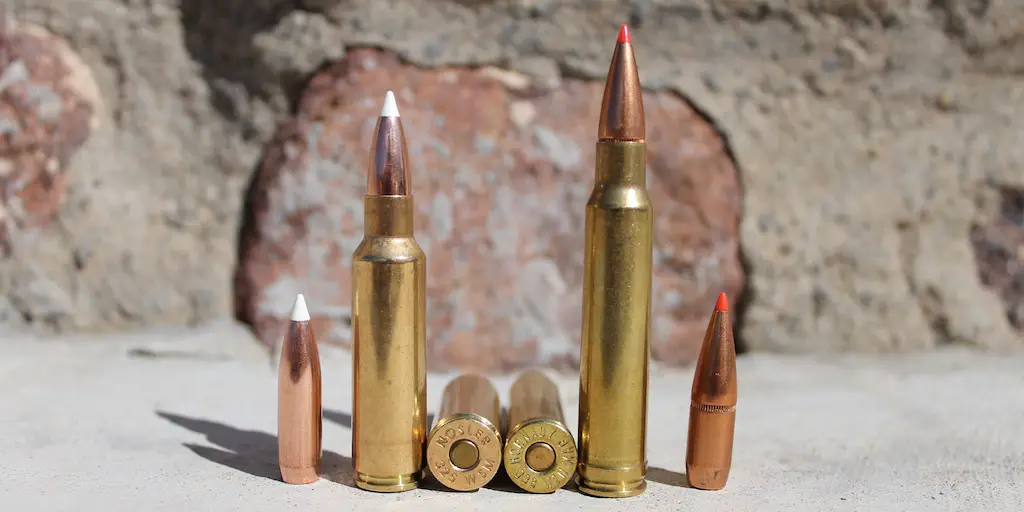
Additionally, the .338 Winchester Magnum is a traditional belted magnum while the 325 WSM has a rebated rim and no belt. The 325 WSM also has a slightly higher maximum SAAMI pressure than the .338 Winchester Magnum (65,000psi vs 64,000psi).Unlike all the other comparisons in this article, the 325 WSM and .338 Win Mag use different sized bullets. The 325 WSM shoots .323″ bullets while the .338 Win Mag uses .338″ bullets.
As a quick aside, the choice of a .323″ (8mm) bullet diameter for the 325 WSM was a pretty big surprise to the shooting industry, which was expecting Winchester to release a 338 WSM instead. However, Winchester likely made an attempt at doing just that, but since the case is optimized for the 300 WSM, they probably were not getting the desired performance with a .338″ bullet and opted for a .323″ compromise instead. Interestingly enough, a .323″ bullet diameter is exactly halfway between the .308″ bullets used by the 300 WSM and .300 Win Mag on one hand, and the .338″ bullets used by the .338 Win Mag on the other.
While there is a big overlap in bullet weights the 325 WSM and .338 Win Mag can use (both cartridges are commonly loaded with bullets in the 180 grain to 250 grain range), the .338 Win Mag generally leans a little heavier than the 325 WSM. Specifically, 180 grain, 200 grain, and 220 grain bullets are most popular for 325 WSM factory ammo. However, 200 grain, 225 grain, and 250 grain bullet weights are most common for .338 Win Mag factory ammo.
Just like with the 7mm WSM vs 7mm Rem Mag and 300 WSM vs 300 Win Mag, even though the 325 WSM uses a case with a larger diameter, the .338 Win Mag itself has a relatively large diameter case and is significantly longer. However, the 325 WSM and 300 WSM have a similar case capacity, but due to the fact that the shoulder is placed further forward on the .300 Win Mag, the .338 Win Mag actually has a little less case capacity than the .300 Win Mag.
For those reasons, while the .338 Win Mag can generally hold a little more powder, the two cartridges actually have similar case capacities (depending on the manufacturer of course).
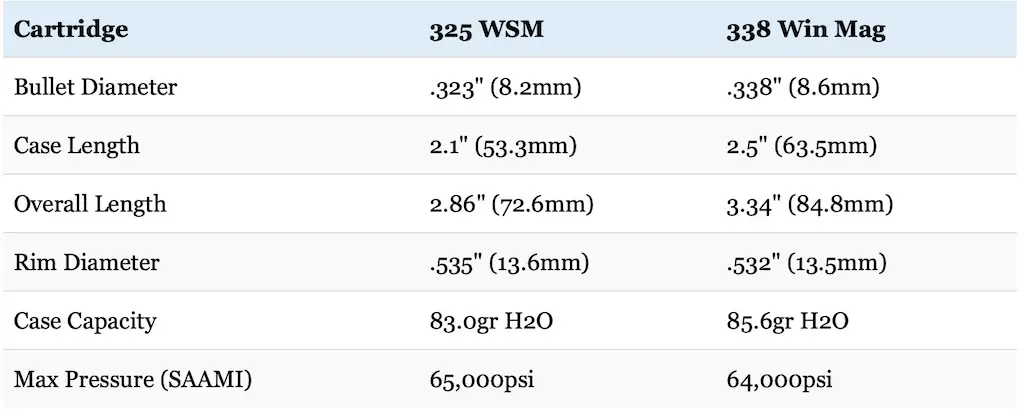
As we’ll discuss in a little more detail later in this article, there is a somewhat limited selection of 325 WSM factory ammo, so it’s tough to conduct a true “apples to apples” comparison of the 325 WSM vs 338 Win Mag ballistics. However, both Nosler and Winchester manufacture their Trophy Grade and Power Max Bonded lines of ammunition in both cartridges.
These are interesting cases where both lines of ammo use the same style bullet for both cartridges, but the Nosler ammunition uses a heavier bullet for the .338 Win Mag and Winchester uses a heavier bullet for the 325 WSM.
Not surprisingly, this results in some interesting ballistic comparisons.
This is illustrated in the table below comparing Nosler Trophy Grade and Winchester Power Max Bonded factory ammunition loaded with 200gr AccuBond (.450 BC) and 220gr (.403 BC) Bonded Rapid Expansion Hollow Point bullets in 325 Winchester Short Magnum and 225gr (.550) AccuBond and 200gr Bonded Rapid Expansion Hollow Point (.323 BC) bullets in .338 Winchester Magnum.
All four loads used a 200 yard zero.
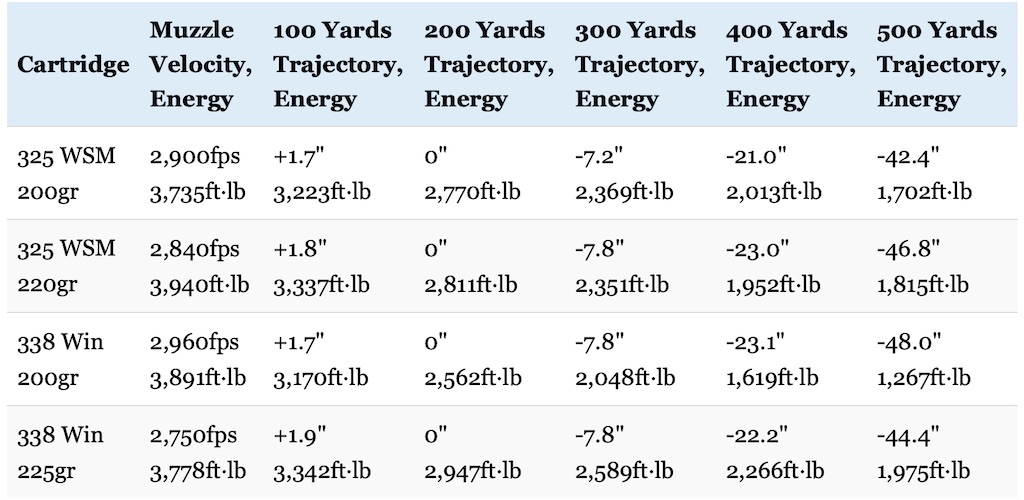
As you can see, both AccuBond loads have similar ballistics, but the 325 WSM AccuBond load has a slightly flatter trajectory while the .338 Win Mag AccuBond load retains more kinetic energy at all ranges. That heavier and more aerodynamic bullet retains energy better at long range and the edge in kinetic energy grows as the distance increases. For instance, the 325 WSM has 99% of the energy of the .338 WSM at the muzzle, 94% at 200 yards, and 86% of the energy of the .338 Win Mag at 500 yards.
The situation is a little different with the Winchester factory load and the 325 WSM has the edge in retained energy. The two cartridges have a virtually identical trajectory out to 400 yards, but the less aerodynamic .338 bullet starts to drop off in performance at longer range compared to the 325 WSM.
What about when comparing bullets of the same or very similar weight?
Well, the 200gr 325 WSM bullet starts off with a little bit less muzzle energy than the 200 grain .338 Win Mag bullet, but the 325 WSM is more aerodynamic and pulls ahead in the energy and trajectory departments at 100 yards and 300 yards respectively. The situation is basically reversed when comparing the 220gr 325 WSM and 225gr 338 Win Mag.
More on this in a minute, but it’s worth noting that for those two AccuBond loads in particular, the 325 WSM has almost 95% of the kinetic energy of the .338 Win Mag and has essentially the same trajectory out to 200 yards.
The chart below compares how much a 10 mile per hour crosswind impacts those same four loads out to 500 yards.
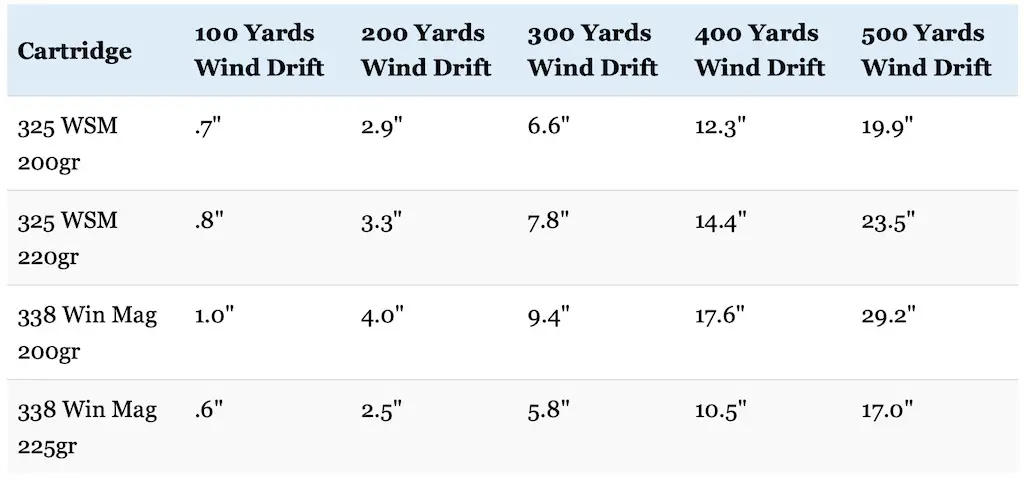
Once again, the results are mixed.
The .338 AccuBond load has a small, but definite advantage in wind drift at all ranges, but the 325 WSM has a bigger edge over the .338 Win Mag with the Winchester loads. Overall, the .338 AccuBond load is the best here with the 325 WSM AccuBond coming in a relatively close second.
Now let’s talk about recoil.
The table below compares the recoil produced by two Nosler hand loads (available here and here) that essentially duplicate the AccuBond loads described above. Both loads are compared when fired from a Winchester Model 70 Featherweight rifle. This specific model weighs 7.25 pounds when chambered in both 325 WSM and .338 Winchester Magnum.
Felt recoil will vary from shooter to shooter and rifle to rifle, but free recoil energy is still a useful way to compare cartridges.
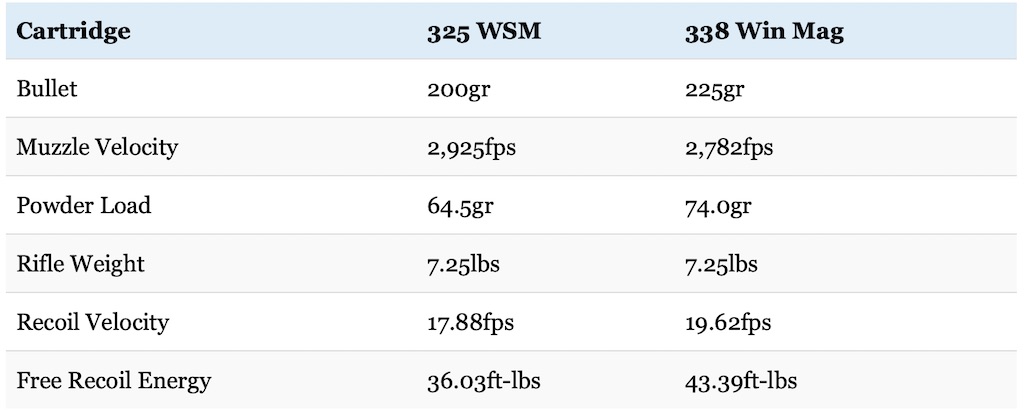
As you can see, that particular 325 WSM load has about 83% of the free recoil energy of the .338 Win Mag load, which is a pretty major reduction in recoil. Like I mentioned a minute ago, that particular 325 WSM load above has essentially the same trajectory and still has about 95% of the kinetic energy of that .338 Win Mag load. That’s is because the 325 Winchester Short Magnum load in question uses about 12% less powder than the .338 Win Mag.
That’s a pretty major step down in recoil, especially when you take into account that you’re getting almost the same amount of performance out to 200-300 yards.
Though Winchester advertises a 24″ long barrel and a 7.25 pound overall weight for each cartridge in this particular Model 70, the rifle chambered in 325 WSM is 1/2″ shorter overall. It’s also possible to find other rifles where there’s an even bigger difference in size and weight between the two cartridges.
For instance, a current production Winchester Model 70 Sporter chambered in 325 WSM weighs about 7.25 pounds and has an overall length of 44.24″. However, the same rifle in .338 Win Mag is advertised at 7.75 pounds and 46.75″ long overall (because it has a 26″ barrel instead of a 24″ barrel like the 325 WSM rifle).
So, depending on the exact rifle model in question, it’s likely that one chambered in 325 WSM will be somewhat shorter and handier as well as potentially a little lighter.
Both rifles in this case also have a 3 round magazine as well, so there’s no advantage there with either cartridge. This is not an ironclad rule though and it’s sometimes possible to find rifles chambered in .338 Winchester Magnum that can accommodate another round or two compared to those chambered in 325 WSM.
In addition to potentially giving up a little bit of magazine capacity due to the fat and stubby design of the 325 WSM cartridge, those same traits (along with the cartridge’s very steep shoulder angle) can sometimes present feeding problems. This is not a guarantee of course and there are 325 WSM rifles feed quite reliably. But, even though the .338 Winchester Magnum does have a belted case (which the 325 WSM lacks), the .338 Win Mag generally has a reputation for pretty reliable feeding in most rifles.
What about accuracy of the 325 WSM vs 338 Win Mag?
As fans of the Winchester Short Magnum cartridges like to point out, the 325 Winchester Short Magnum likely does gain some accuracy benefit from its shorter powder column.
However, while that may well contribute somewhat to improved accuracy, there are many other factors that influence accuracy to a much larger degree.
Is the 325 WSM capable of excellent accuracy? Absolutely.
Is it significantly more accurate than the .338 Winchester Magnum? Maybe, but I doubt that it’s a big enough difference to really matter.
Does the difference between the two cartridges in terms of accuracy make a difference for most hunters under typical conditions? Again, probably not.
Remember: we’re talking about accuracy under practical hunting conditions, not benchrest shooting where a tiny improvement in group size can make a big difference. While it’s certainly nice to have if possible, a the difference in a theoretical 1.25″ vs a 1.5″ group most likely won’t matter much while actually hunting at reasonable ranges.
The answers to the above questions really depend on the rifle, ammunition, and shooter in question though. However, both cartridges are capable of excellent accuracy in the right hands and will get the job done under most circumstances if the shooter is up to the task.
What about rifles and ammunition?
Though it’s not quite as commonly used as cartridges like the .270 Winchester, 7mm Remington Magnum, or .300 Winchester Magnum, the .338 Winchester Magnum is still quite popular. I’m not sure if it cracks the Top 10 best selling rifle cartridges in the United States each year, but it’s likely in the Top 15 or Top 20. That said, while the 325 WSM is quite popular in some circles, it is not nearly as widely used and cannot hold a candle to the .338 Win Mag in that area.
While virtually every big ammo manufacturer produces factory hunting ammo for the .338 Win Mag, only Nosler and Winchester Ammunition currently produce 325 WSM hunting ammo as part of their Trophy Grade, Expedition Big Game, Power Max Bonded, and Super X lines (loaded with the AccuBond, E-Tip, AccuBond CT, Bonded Rapid Expansion Hollow Point, and Power-Point bullet respectively), For those reasons, most sporting goods stores usually carry ammunition for the .338 Win Mag, but 325 WSM ammo can be significantly harder to find.
Reloading components for the .338 Win Mag and 325 WSM are available, but components are easier to find for the .338 Win Mag. The .338 Winchester Magnum (along with the .338 Federal, .338 Lapua, .340 Weatherby Magnum, .338 Ruger Compact Magnum, and .338 Remington Ultra Mag) all use the same .338″ bullets. However, the 8mm bullets (.323″) used by the 325 WSM (as well as the 8mm Mauser, 8mm Rem Mag, and 8×68 S) are not nearly as easy to find in the United States.
This is one of the tougher aspects of using the 325 WSM: there’s not a gigantic variety of factory ammo or a large number of bullet choices for hand loaders to choose from. Hunters who look hard enough can probably find what they need, but it can be challenging sometimes.
The situation with rifles in is pretty similar. Most manufacturers produces rifles chambered in .338 Win Mag, so it’s not too difficult to find a good rifle in that cartridge. However, though Browning, Kimber, and Savage all manufactured 325 WSM rifles at one point, only Winchester currently offers current production rifles in the cartridge (the Model 70 and XPR at this point).
So where do we stand with both cartridges?
The .338 Winchester Magnum and 325 Winchester Short Magnum cartridges have similar, external ballistics, especially at ranges inside 300 yards. Both are also capable of outstanding accuracy in the right hands. However, similar to the case of the 300 WSM vs 300 Win Mag, the 325 WSM is capable of attaining almost the same performance as the .338 Win Mag while using less powder. This results in less recoil.
Both cartridges also offer a substantial increase in power, both in terms of bullet frontal surface area and kinetic energy, over the 300 Magnums as well.
For this reason, while they will do the job on deer sized game, the 325 WSM and .338 Win Mag are both excellent choices for larger game like caribou, elk, moose, red stag, kudu, and eland. Especially when hunting at shorter ranges (inside 200 yards), the 325 Winchester Short Magnum offers virtually the same performance as the .338 Win Mag, but with considerably less recoil.
All told, both are wonderful cartridges for hunting some of the larger species of North American big game or African plains game.
With that in mind, the 325 WSM is a better choice for situations where very large and tough game like sambar deer or moose are likely to be encountered at close range. That’s not to say that the .338 Win Mag won’t work for that sort of hunting because it certainly will. It’s just that it doesn’t offer a significant improvement in power over the 325 WSM at close range, but still has more recoil.
At the same time, the lighter recoil and flatter trajectory of the 325 WSM give it a bit of a leg up on .338 Win Mag for hunting deer sized game where the extra power of the .338 Win Mag isn’t as useful.
While both cartridges are really too light for hunting extremely large, thick skinned dangerous game like cape buffalo, they will both fit the bill for hunting Grizzly or Alaska Brown Bear. Even so, I’d personally lean towards .338 Win Mag since it generally functions more reliably, shoots larger diameter bullets, and is usually a tiny bit more powerful.
The verdict?
They’re both great cartridges and I’d personally say that the 325 WSM is the second most appealing choice out of the Winchester Short Magnum line (behind the 300WSM). The 325 WSM is an attractive choice for hunters in the niches I described above and those that use the cartridge generally seem to absolutely love it.
Which one is right for you?
For the majority of hunters, the .338 Winchester Magnum is the more practical choice. While the performance of the two cartridges at reasonable hunting ranges is very similar, the logistics of getting a good rifle, quality ammunition, or even reloading components for the .338 Win Mag are so much simpler for that cartridge when compared to the 325 WSM.
Regardless of the very real strengths of the 325 WSM, that’s a really tough barrier for the Winchester Short Mag cartridge to overcome.
Winchester Short Magnum Conclusions
The Winchester Short Magnum line of cartridges is a good example of how even well designed products that largely accomplish the goals set by the manufacturer can fail to catch on with the hunting community. By and large, the 270 WSM, 7mm WSM, 300 WSM, and 325 WSM are all capable of excellent accuracy and essentially duplicate the performance of comparable standard length cartridges while fitting in a short action.
The 300 WSM and 325 WSM also have the benefit of doing all of the above with a modest decrease in recoil compared to the .300 Win Mag and .338 Win Mag while the 270 WSM offers a definite improvement in velocity over the .270 Winchester.
However, the biggest shortcoming of all four Winchester Short Magnum cartridges is the fact that they often simply don’t provide enough advantages to most hunters to justify switching over, particularly if that hunter is already using a more established cartridge that works well for him or her.
That’s not meant to be a knock on the Winchester Short Magnum line either.
Like I said, they’re all well designed and very capable hunting cartridges. However, they’re being measured against four of the most popular American centerfire rifle cartridges of all time in the .270 Winchester, 7mm Remington Magnum, .300 Winchester Magnum, and .338 Winchester Magnum, and that’s a tough hurdle to get over.
Since those older cartridges already have such well established (and deserved) reputations, not to mention an abundant selection of quality rifles and ammunition, any new cartridge competing against them had better provide a significant advantage to convince enough people to make that switch.
Looking at it that way, it’s not surprising that the 7mm WSM is likely on its way out.
At the same time, the 300 WSM has most closely lived up to the hype, which explains why it’s far and away the most popular of the bunch.
The 270 WSM and 325 WSM are more of a mixed bag, but offer advantages to hunters in certain aspects as well and this is reflected in their popularity in particular segments of the hunting community as a whole.
The Winchester Short Mags all undoubtedly offer at least some advantages to the shooter that, if nothing else, can potentially help improve his or her confidence and maximize his or her shooting abilities. This is a benefit that should not be overlooked either.
The fact of the matter is that regardless of the rifle cartridge in question, the shooter is almost always the weakest link in the accuracy equation. On paper, the Winchester Short Magnums are very closely matched with their standard length cousins. However, as long as you can find a rifle and ammunition combination that function reliably and shoot accurately together, if using one of those cartridges improves the confidence of the shooter to a large enough degree, then by all means start hunting with a Winchester Short Magnum cartridge.
Are you just itching to take a rifle chambered in one of these cartridges on a hunt?
Book a great black bear hunt here.
Book an incredible Africa hunting safari here.
Enjoy this article analyzing the Winchester Short Magnum line of cartridges and comparing the 270 WSM vs 270, the 7mm WSM vs 7mm Rem Mag, the 300 WSM vs 300 Win Mag and the 325 WSM vs 338 Win Mag? Please share it with your friends on Facebook and Twitter.
The Lyman 50th Edition (p197-198, 199-200, 214-216, 219-220,257-259, 260-262, 288-289, 294-295) and Hornady 10th Edition (p351-359, 356-359, 406-411, 412-416, 564-573, 574-585, 637-639, 659-664) reloading manuals were used as references for the history of the cartridges. The data used to compare the trajectory and wind drift of the cartridges was obtained from Hornady (here, here, here and here), Federal (here, here, here, here, here, and here), Nosler (here), and Winchester (here). Case capacities and reloading data were obtained from Chuck Hawks and Nosler (here, here, here, here, here, here, here, and here). Maximum pressure obtained from SAAMI (p23, 24, 28, 30, 31, and 32). I used the Hornady Ballistic calculator and ShootersCalculator.com to compare trajectory, wind drift, and recoil for the cartridges.
Make sure you subscribe to The Big Game Hunting Podcast and follow The Big Game Hunting Blog on Facebook, Instagram, Twitter, and YouTube
NEXT: 270 vs 308 WIN: WHICH ONE SHOULD YOU HUNT WITH?
John McAdams is a proficient blogger, experienced shooter, and long time hunter who has pursued big game in 8 different countries on 3 separate continents. John graduated from the United States Military Academy at West Point and is a veteran of combat tours with the US Army in Iraq & Afghanistan. In addition to founding and writing for The Big Game Hunting Blog, John has written for outdoor publications like Bear Hunting Magazine, The Texas State Rifle Association newsletter, Texas Wildlife Magazine, & Wide Open Spaces. Learn more about John here, read some of John’s most popular articles, and be sure to subscribe to his show: the Big Game Hunting Podcast.




Glad to see the WSM family got some attention. Your write ups always offer very practical and useful information. I am a fan of the WSM cartridges. None of them have covered any new ground. However, the rifles are noticeably lightweight, offering non belted magnum performance; that all shoot accurately. I went with the 325 to try something different for a change. The great thing about the WSM family is that converting one to another is easy if the others die off(270,300,325). You got to figure one or two should survive.
Great article, but I’ve always felt the 270 WSM should be compared to the 30-06. Compare the 180 gr 30-06 verses the 150 gr 270 WSM and you get the same or possibly less recoil and better ballistics all around except energy with the 270 WSM. Having said all that, when I recently compared the two, I ended up with the 7mmRM.
I’ve always thought the 270wsm was similar to the 7mm Mag. I’d have to compare the ballistics to double check
that. But off the top of my head it would seem to be the case. Anyhow, I like the concept of the wsm family of cartridges.
Lightweight handy rifles giving magnum performance should have become more popular. I guess riflemen are becoming
wusses when it comes to recoil. Ok let’s give them the benefit of the doubt and say they like availability and reliable feeding.
In today’s world, better to sugar coat it than to sound like we may be mocking. After all we wouldn’t want to hurt someone’s sensitive feelings. LMAO
I purchased a Browning AB3 in the 300wsm set it up with a Nikon scope and put a slip proof sling on it… THEN, I purchased the the “twin” in a 270wsm and did the same thing I did with the 300wsm.. I gave them to my son to be distributed upon my death.. I want to purchase the 7mm wsm and the 325wsm before this happens.
We’ve never fired these along with other rifles that I bought.. I wanted to keep them NEW but in the gun safe. I don’t think I made a mistake of their purchases along with the 7mm Rem. mag, 300Win. mag and the 6.5 Creedmoor and a few others. But I wanted to get the entire line of Brownings AB3 Hunter’s.. so I have to find N.I.B. the 7mm wsm and the 325wsm.
For the majority of hunters, the .338 Winchester Magnum is the more practical choice. While the performance of the two cartridges at reasonable hunting ranges is very similar, the logistics of getting a good rifle, quality ammunition, or even reloading components for the .388 Win Mag are so much simpler for that cartridge when compared to the 325 WSM.
edit to: .338 Win Mag
Thanks for pointing out that typo Jerry. I just changed the .388 to .338 like it should be.
John
John McAdams does a great job with Biggamehuntingblog . Content is great.
Lots of good links too.